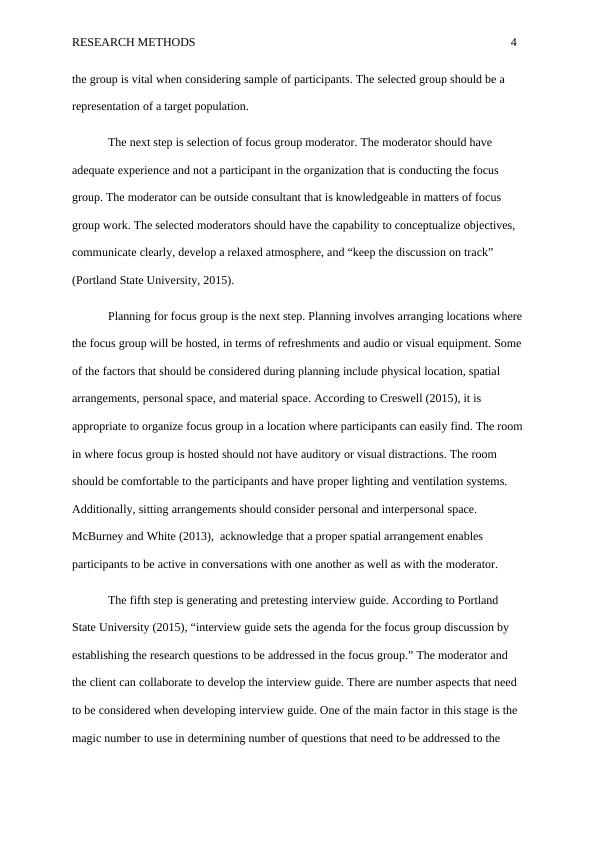Overview and Analysis of Research Methodologies
Added on 2021-05-30
14 Pages4102 Words30 Views
Running Head: RESEARCH METHODS 1Research MethodsNameInstitution

RESEARCH METHODS 2Research MethodsResearch methods are fundamental in studying of social and economic behaviours as well as developing scientific studies, which opens the window for specific analysis based on the methodology that the researcher is applying. In practice, the researcher usually selects the research method that is suitable for the situation under analysis. First segment of the paper provides an overview on focus group research method. Second section of the paper discusses how researcher should select respondents for study to provide benefits for using probability and non-probability sampling. The subsequent parts addresses research design, merits and demerits of qualitative and quantitative research techniques, and differences between probability and non-probability sampling. Part I: Focus GroupFocus Group refers to “an exploratory research method used to help researchers gather in-depth, qualitative information of their participants' attitudes and perceptions relatingto concepts, products, services, or programs” (Portland State University, 2015, p.1). Ideally, one of the rationale for conducting focus group is to generate new idea. An open discussion with participants provides a springboard to evaluate the service delivery of the organization and stakeholder’s satisfaction. It also enables the researcher to explore the members’ reactions to the new systems of subscriptions. More importantly, conducting focus groups enhances formulation of hypotheses to be tested for quantitative surveys (Portland State University, 2015). The exercise also enables the researcher to conceptualize previously collected quantitative data. Some of the factors incorporated in the process of conducting focus group include confidentiality, location, time, budget, accuracy, moderator, accuracy, homogeneity, and specification of users’ needs.

RESEARCH METHODS 3Carey and Asbury (2012) identify nine steps that should be followed during development and implementation of focus groups. The first step conducting focus group is establishment of research agenda. I would develop topics of discussions using outline (Green and Thorogood, 2018). I would prepare the outline by consulting with participants to be included in the study. Through consultations with the union members, it would be easy to develop a plan of action. Myers (2013) asserts that the plan should encompass identification of research questions and objectives, features of the sample to include, budget, and the timeline for the entire research process. According to (McBurney and White, 2013), the problem definition should capture specific information on topic of interest and well-defined objectives.The second step is identification of the sample characteristics. Green and Thorogood, (2018) acknowledge that effectiveness of the focus group vests on recruitment of participants.However, the researcher needs to be careful on matters of group composition since “quality and the direction of the discussion determine” relies on the interaction of the participants within groups (Portland State University, 2015). Four factors must be taken into consideration when assessing the sample of participants to be employed. The first factor is the element of group homogeneity. Myers (2013) maintains that the homogeneity of the group is fundamental. However, it must have some sufficient variations to provide room for contrasting opinions. In this context, I would seek homogeneity in terms of education level, age, family characteristics, gender, and age. Another factor that should be given priority during determining of sample of participants is intrapersonal characteristics. This involves using aspects of personality, geographic, and physical features in determining the reaction and group behaviour. On the size of the focus group, I would consider 6 to 10 participants. Queirós et al (2013) observe that larger groups reduce chances of participants contribute while smaller ones limits range of experiences to be shared. Moreover, representativeness of

RESEARCH METHODS 4the group is vital when considering sample of participants. The selected group should be a representation of a target population. The next step is selection of focus group moderator. The moderator should have adequate experience and not a participant in the organization that is conducting the focus group. The moderator can be outside consultant that is knowledgeable in matters of focus group work. The selected moderators should have the capability to conceptualize objectives, communicate clearly, develop a relaxed atmosphere, and “keep the discussion on track” (Portland State University, 2015).Planning for focus group is the next step. Planning involves arranging locations wherethe focus group will be hosted, in terms of refreshments and audio or visual equipment. Someof the factors that should be considered during planning include physical location, spatial arrangements, personal space, and material space. According toCreswell (2015), it is appropriate to organize focus group in a location where participants can easily find. The roomin where focus group is hosted should not have auditory or visual distractions. The room should be comfortable to the participants and have proper lighting and ventilation systems. Additionally, sitting arrangements should consider personal and interpersonal space. McBurney and White (2013), acknowledge that a proper spatial arrangement enables participants to be active in conversations with one another as well as with the moderator. The fifth step is generating and pretesting interview guide. According to Portland State University (2015), “interview guide sets the agenda for the focus group discussion by establishing the research questions to be addressed in the focus group.” The moderator and the client can collaborate to develop the interview guide. There are number aspects that need to be considered when developing interview guide. One of the main factor in this stage is the magic number to use in determining number of questions that need to be addressed to the

End of preview
Want to access all the pages? Upload your documents or become a member.
Related Documents
Marketing Research Essentialslg...
|7
|1509
|331
HI6008 - Report on Learning Method & Procedurelg...
|11
|1872
|36
The Role of Line Managers and Leaders in Employee Development and Well-being within Hospitality Industrylg...
|19
|3286
|88
Business Researchlg...
|4
|1271
|65
Research Methods in a Mixed Business Study Assignment PDFlg...
|4
|770
|256
Qualitative Research: Assessing the Importance of Human Resources and Strategies Development in South Africa and Setaslg...
|4
|784
|259
